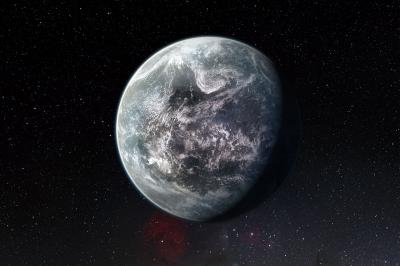Planets outside our solar system more hospitable to life than thought
January 16, 2015

This artist’s impression shows the planet orbiting the Sun-like star HD 85512 in the southern constellation of Vela (The Sail). This planet is one of sixteen super-Earths discovered by the HARPS instrument on the 3.6-metre telescope at ESO’s La Silla Observatory. This planet is about 3.6 times as massive as the Earth and lies at the edge of the habitable zone around the star, where liquid water, and perhaps even life, could potentially exist (credit: ESO/M. Kornmesser)
A study by astrophysicists at the University of Toronto suggests that exoplanets — planets outside our solar system — are more likely to have liquid water and be more habitable than we thought.
Scientists have thought that exoplanets behave in a manner contrary to that of Earth — that is, they always show their same side to their star.
If so, exoplanets would rotate in sync with their star (as our Moon does with Earth), so that there is always one hemisphere facing it while the other hemisphere is in perpetual cold darkness.
However the new study by Jérémy Leconte, a postdoctoral fellow at the Canadian Institute for Theoretical Astrophysics (CITA) at the University of Toronto, and his team suggests that as exoplanets rotate around their stars, they spin at such a speed as to exhibit a day-night cycle similar to Earth. Leconte is lead author of the study, published Thursday Jan. 15 in Science Express.
“If we are correct, there is no permanent, cold night side on exoplanets causing water to remain trapped in a gigantic ice sheet,” he said. “Whether this new understanding of exoplanets’ climate increases the ability of these planets to develop life remains an open question.”
Atmosphere effects on rotation speed
Leconte and his team reached their conclusions via a three-dimensional climate model they developed to predict the effect of a given planet’s atmosphere on the speed of its rotation, which results in changes to its climate,” said Leconte. “Atmosphere is a key factor affecting a planet’s spin, the impact of which can be of enough significance to overcome synchronous rotation and put a planet in a day-night cycle.”
Though astronomers are still awaiting observational evidence, theoretical arguments suggest that many exoplanets should be able to maintain an atmosphere as massive that of Earth.
In Earth’s case, with its relatively thin atmosphere, most of the light from the Sun reaches the surface of the planet, maximizing the effect of heating throughout the atmosphere and producing a more moderate climate across the planet. By creating temperature differences at the surface, between day and night and between equator and poles, the solar heating drives winds that redistribute the mass of the atmosphere.
The impact is so significant that it overcomes the effect of tidal friction exerted by a star on whatever satellite is orbiting it, much like Earth does on the Moon.
“The Moon always shows us the same side, because the tides raised by Earth create a friction that alters its spin,” said Leconte. “The Moon is in synchronous rotation with Earth because the time it takes to spin once on its axis equals the time it takes for it to orbit around Earth. That is why there is a dark side of the moon. The tidal theory, however, neglects the effects of an atmosphere.”
The researchers say that a large number of known terrestrial exoplanets should not be in a state of synchronous rotation, as initially believed. While their models show that they would have a day-night cycle making them much more similar to Earth, the duration of their days could last between a few weeks and few months.
Abstract of Asynchronous rotation of Earth-mass planets in the habitable zone of lower-mass stars
Planets in the habitable zone of lower-mass stars are often assumed to be in a state of tidally synchronized rotation, which would considerably affect their putative habitability. Although thermal tides cause Venus to rotate retrogradely, simple scaling arguments tend to attribute this peculiarity to the massive Venusian atmosphere. Using a global climate model, we show that even a relatively thin atmosphere can drive terrestrial planets’ rotation away from synchronicity. We derive a more realistic atmospheric tide model that predicts four asynchronous equilibrium spin states, two being stable, when the amplitude of the thermal tide exceeds a threshold that is met for habitable Earth-like planets with a 1 bar atmosphere around stars more massive than ~0.5 – 0.7 M☉. Thus, many recently discovered terrestrial planets could exhibit asynchronous spin-orbit rotation, even with a thin atmosphere.